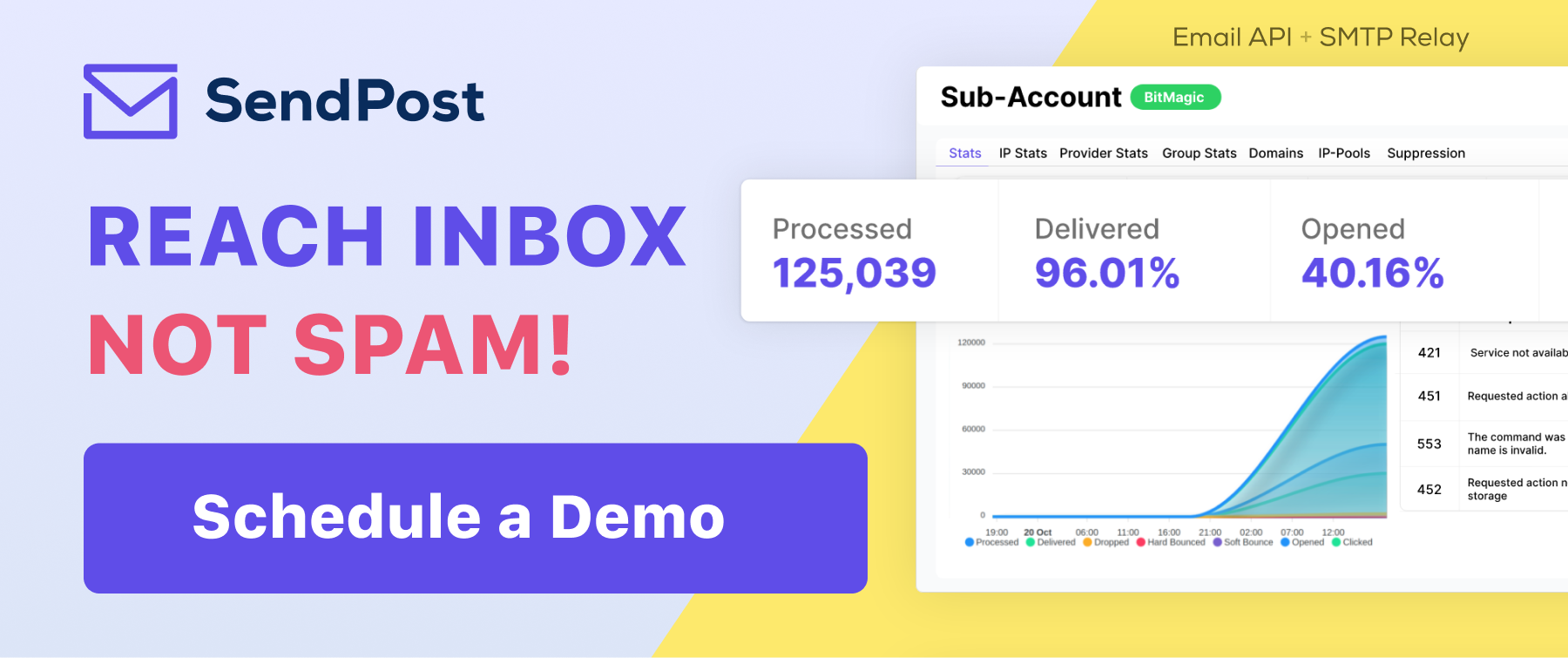SendPost Blog - Email API & SMTP
How to Maintain High Email Deliverability: 5 Tips for Regular Maintenance

How to Maintain High Email Deliverability: 5 Tips for Regular Maintenance
As a savvy marketer, you've likely recognized the significance of achieving good email deliverability and have put in the effort to optimize your strategies accordingly. However, what many fail to realize is that attaining high deliverability is not a one-time accomplishment; it requires ongoing attention and regular maintenance.
Even a single slip-up, one ill-advised decision or oversight, can send your deliverability rates plummeting. Suddenly, your meticulously crafted emails are diverted to spam folders or worse, blocked altogether. Restoring your deliverability reputation becomes an arduous task, requiring ten times the effort and resources to regain the trust of both email service providers (ESPs) and your recipients.
However, the consequences extend far beyond the restoration process itself. During the period of diminished deliverability, your engagement levels suffer, resulting in missed opportunities, reduced conversions, and potential revenue loss.
In this blog, we will explore essential tips and strategies to help you maintain high email deliverability through regular maintenance. By proactively addressing potential pitfalls, staying informed about industry best practices, and continuously optimizing your email campaigns, you can safeguard your deliverability rates, ensuring consistent success and sustained engagement with your audience.
1. Maintain Proper Email Authentication
It involves setting up three key authentication protocols: SPF (Sender Policy Framework), DKIM (DomainKeys Identified Mail), and DMARC (Domain-based Message Authentication, Reporting, and Conformance). Let's break down each of these protocols and understand their role in verifying your email's legitimacy.
- SPF (Sender Policy Framework): Think of SPF as a virtual bouncer at the entrance of a nightclub. It helps email receivers verify that the email they received is from an authorized sender. SPF works by adding a DNS (Domain Name System) record to your domain's settings. This record specifies the IP addresses or domains authorized to send emails on your behalf. When an email is received, the receiving server checks the SPF record to validate the sender's identity. If the sender matches the authorized IP addresses or domains, the email is considered legitimate.
3. DMARC (Domain-based Message Authentication, Reporting, and Conformance): DMARC builds upon SPF and DKIM to provide further email authentication and reporting capabilities. It allows you to define policies on how your emails should be handled if they fail SPF or DKIM checks. With DMARC, you can specify whether such emails should be delivered, quarantined, or rejected. Additionally, DMARC provides valuable reporting insights, giving you visibility into how your emails are being handled by receivers and potential issues with authentication.
By implementing SPF, DKIM, and DMARC authentication, you establish a robust system that verifies your email's legitimacy. This not only reduces the chances of your emails being flagged as spam but also enhances your sender reputation.
Setting up these authentication protocols may involve technical configurations within your email server or domain settings. It's advisable to consult with your IT department. If you use a provider like Sendpost.io, this will be taken care of for you.
2. Use Double Opt-in
Using a double opt-in process is a highly recommended method to ensure the quality and accuracy of your email subscriber list. It involves an additional step to confirm a subscriber's intentions after they initially provide their email address. Let's delve deeper into the benefits and steps involved in implementing a double opt-in process.
- Confirming Subscribers' Intentions: The primary goal of a double opt-in process is to verify that subscribers genuinely want to receive emails from your business. With a single opt-in, anyone can enter an email address, intentionally or accidentally, leading to fake or mistyped addresses polluting your list. By requiring subscribers to confirm their intentions, you ensure that only engaged individuals who genuinely want to receive your emails become part of your list.
- Enhancing List Quality: Implementing a double opt-in process significantly improves the quality of your email subscriber list. It acts as a filter, weeding out invalid or mistyped email addresses. When subscribers receive a confirmation email, they must take an extra step to confirm their subscription by clicking a link or taking another specified action. This additional verification step minimizes the chances of spam traps, reduces bounce rates, and improves the overall deliverability of your emails.
Steps Involved in Double Opt-In:
To set up a double opt-in process, follow these key steps:
a. Subscriber Signup: Provide a clear and prominent signup form on your website or landing page, where visitors can enter their email addresses to subscribe to your email list.
c. Confirmation Action: In the confirmation email, ask subscribers to click on a unique confirmation link or take another specified action (such as replying to the email) to confirm their subscription.
3. Maintain Consistent Sending Patterns
Maintaining consistent sending patterns is crucial for maintaining high email deliverability and keeping a positive relationship with both your subscribers and Internet Service Providers (ISPs). Let's explore why establishing a regular sending schedule is important and how it helps you avoid potential issues.
- Subscriber Expectations: Consistency is key when it comes to engaging your email subscribers. By establishing a regular sending schedule, you meet your subscribers' expectations and provide them with a predictable experience. When subscribers know when to expect your emails, they are more likely to engage with and open them. Consistency builds trust and helps you stay top of mind with your audience.
- ISP Reputation: ISPs closely monitor email senders for any irregularities in sending behavior. Sudden spikes or lulls in your email frequency can raise red flags and trigger suspicion. ISPs may perceive irregular sending patterns as potential indicators of spam or malicious activity. This can lead to your emails being filtered to spam folders or even blocked entirely. By maintaining a consistent sending pattern, you establish a positive reputation with ISPs, enhancing the chances of your emails reaching your subscribers' inboxes.
Tips for Maintaining Consistent Sending Patterns:
a. Determine a Sending Frequency: Determine the ideal sending frequency based on your subscribers' preferences, content availability, and your marketing goals. It can be daily, weekly, bi-weekly, or monthly, depending on your specific circumstances.b. Communicate the Sending Frequency: Inform your subscribers about your email frequency during the signup process or through a welcome email. Set clear expectations, and allow subscribers to adjust their preferences if possible.
c. Stick to the Schedule: Once you establish a sending schedule, stick to it as much as possible. Consistency is key to building trust and meeting subscribers' expectations.
For example, SendX newsletter is sent consistently every Tuesday.
4. Give an Easy Way to Unsubscribe
By providing clear unsubscribe options, you empower recipients to control their email preferences, reduce the risk of spam complaints, and improve your overall email deliverability.
a. Visible Placement: Place the unsubscribe link or button prominently in your emails, preferably at the top or bottom. Use a font size and color that is easily noticeable and distinguishable from the rest of the text.b. Clear Language: Use clear and straightforward language to indicate that the link or button is for unsubscribing. Phrases such as "Unsubscribe" or "Opt-Out" are widely recognized and understood by recipients.
c. Single-Click Unsubscribe: Make the unsubscribe process as frictionless as possible. When a recipient clicks on the unsubscribe link, direct them to a dedicated unsubscribe page where they can confirm their choice with a single click. Avoid asking for additional information or making the process overly complicated.
e. Provide Subscription Preferences: Consider offering a preference center where recipients can manage their subscription preferences rather than unsubscribing completely. This allows them to customize the types of emails they receive, helping retain engagement while respecting their preferences.
5. Regularly Review and Update Your Email Content
By regularly reviewing and updating your email content, you ensure that it remains fresh, relevant, and engaging for your subscribers. This approach helps you avoid triggering spam filters, maintain a positive sender reputation, and deliver emails that resonate with your audience.
- Fresh and Relevant Content: Stale or outdated content can lead to disengagement and a higher likelihood of recipients marking your emails as spam. Stay on top of trends, audience preferences, current designs etc.
- Avoid Excessive Images: While images can enhance the visual appeal of your emails, excessive use of images can trigger spam filters. Some email clients and ISPs interpret emails with a high image-to-text ratio as potentially spammy. To avoid this, balance your email content with a combination of text and images. Use alt text for images and provide a text-based version of your email to ensure accessibility for all recipients.
- Be Mindful of Attachments: Attachments can raise suspicion and trigger spam filters. Instead of attaching files, consider hosting the content online and providing a link in your email. This approach ensures that your emails remain lightweight and bypass potential filters associated with attachments.
- Avoid Misleading Information: Using misleading or deceptive information in your emails can quickly raise red flags with both recipients and spam filters. Be honest and transparent in your subject lines, email content, and calls-to-action. Misleading tactics can harm your sender reputation and result in higher spam complaints and lower engagement rates
Tools to Help You Maintain High Email Deliverability
Now, you might be wondering, "Are there any tools out there that can make this process easier?" Well, there are indeed plenty of email deliverability tools on the market, each with its own strengths and weaknesses. But let me introduce you to a friendly and affordable option – SendPost.
SendPost is an email automation platform that doesn't break the bank. It offers robust features without compromising on simplicity. Whether you're sending personalized newsletters or running large-scale campaigns, SendPost ensures your emails land where they belong – in your subscribers' inboxes.
So, why settle for less when you have a solution like SendPost that provides quality and affordability? Give it a try with a free trial or schedule a demo to see how it can streamline your email processes and make maintaining high deliverability a breeze.







![A Definitive Guide to Email Deliverability [Updated 2022]](https://www.sendpost.io/hubfs/A-Definitive-Guide-to-Email-Deliverability.png)

